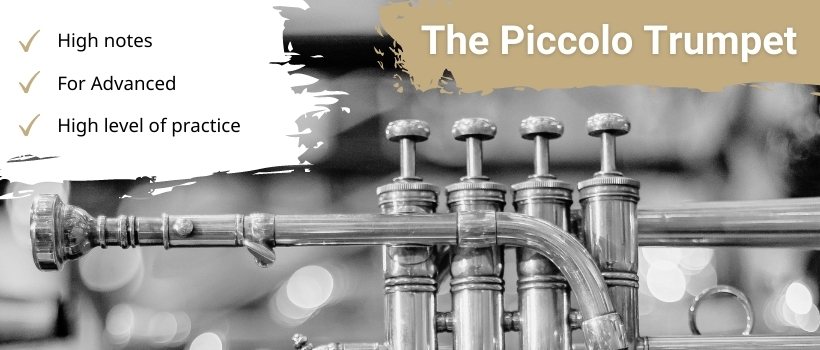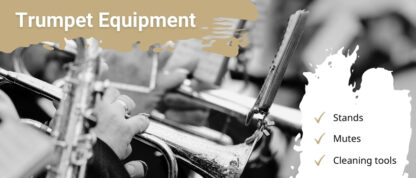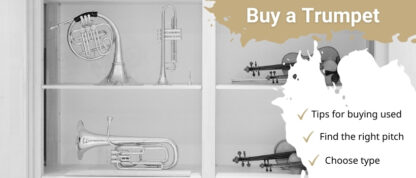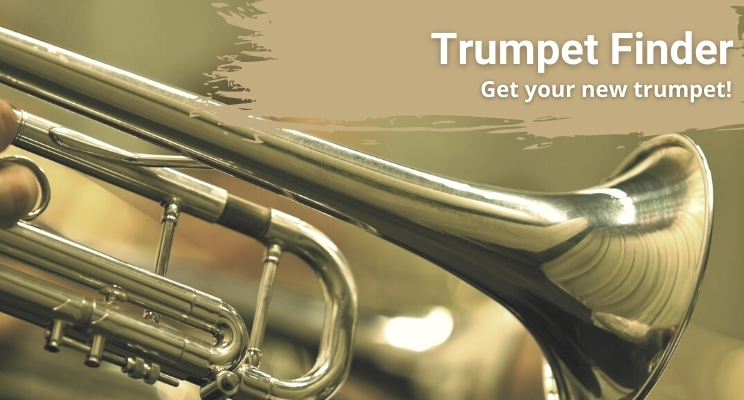The name lives up to its promise: the piccolo trumpet is the smallest of the trumpets. It is mainly used for the higher pitches, as its range starts at d’ and is open towards the top according to the player’s ability. Because of its size, the piccolo trumpet sounds somewhat more pointed and thinner than a Bb trumpet. This makes it rather unsuitable for jazz music, but all the more popular for signal positions in classical pieces.
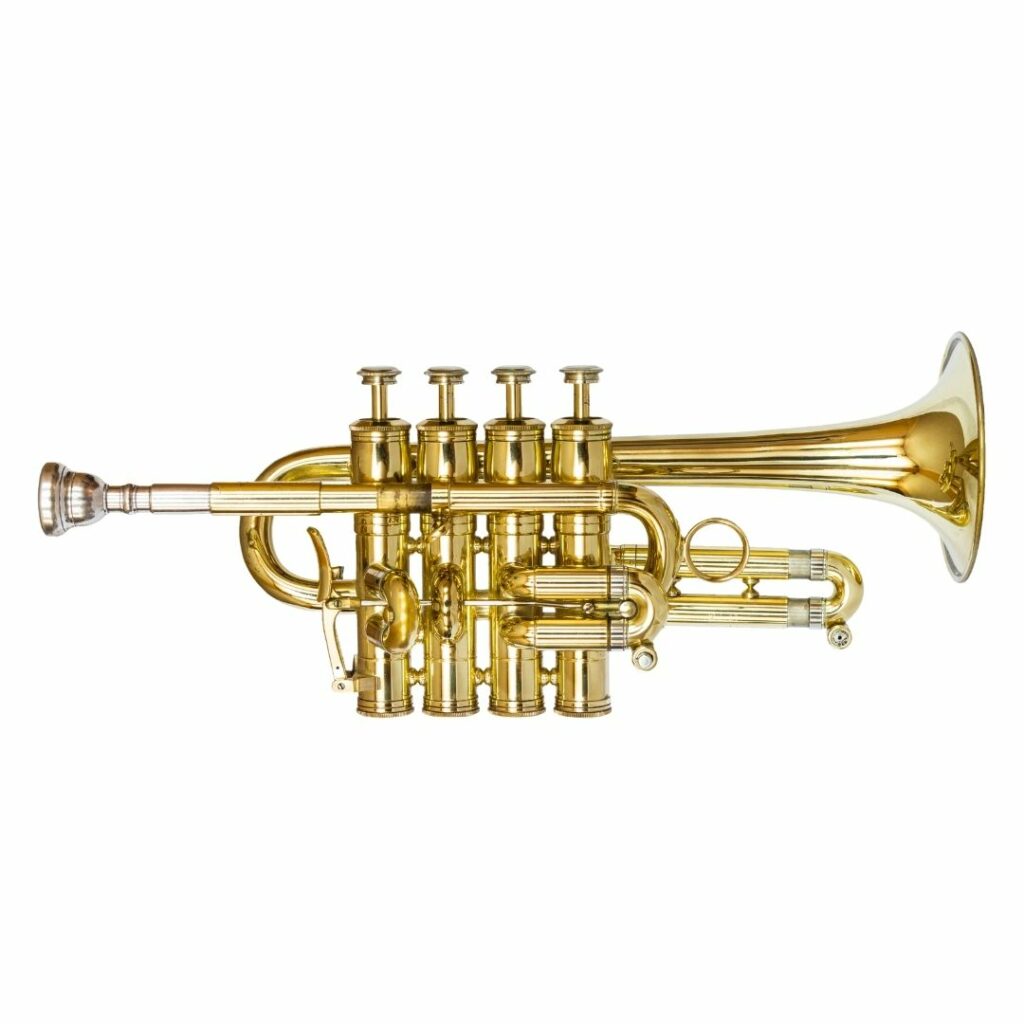
What distinguishes the piccolo trumpet?
The piccolo trumpet is characterised above all by its short tube length. However, it should not be confused with a pocket trumpet. This is similar to a conventional trumpet, but its structure is more compact due to several windings and therefore fits in any pocket. The piccolo trumpet also has a fourth valve to facilitate intonation and fingering.
For whom is the piccolo trumpet suitable?
The piccolo trumpet is not a beginner’s instrument. Anyone who wants to play it should already have a good embouchure and be able to play stable trebles. Although the high notes on the piccolo trumpet are easier and more accurate to achieve, the amount of practice required for this instrument is nevertheless very high.
What does the piccolo trumpet sound like?
Basically, the piccolo trumpet sounds higher than a normal Bb trumpet. How high depends on the skill of the player. Its range begins at d’. Usually the piccolo trumpet is tuned in Bb/A. In this case it is equipped with 2 mouthpieces – one for each pitch. However, the piccolo trumpet is also available in the tunings G/F, Eb, Eb/D or high C.
You can convince yourself of the sound of the piccolo trumpet in this video:
Which equipment is available for the piccolo trumpet?
Especially for piccolo trumpets in Bb/A tuning, you need at least two mouthpieces. But there are also some other equipment for your trumpet, so that you can enjoy it for a long time.
Mouthpieces for the piccolo trumpet
When playing the trumpet, the sound is not produced by a reed, as is the case with the clarinet, for example. Instead, the lips of the player become the tone generator. They are set in vibration and transfer this to the air, which causes the sound to be heard inside the instrument. It is therefore all the more important to find a mouthpiece that suits the individual physiognomy. The mouthpieces differ mainly in 3 points:

- The rim width: The rim width of the mouthpiece varies from narrow to wide and from flat to rounded. A wide rim is comfortable to play, but it also affects the way the lips vibrate. This may make the response more difficult. A narrow, pointed rim, on the other hand, provides a fast and precisely defined tone, but can also have a detrimental effect on endurance.
- The rim diameter: The rim diameter of the mouthpiece is between 14 and 18 millimetres. It determines how much space your lips have in the mouthpiece to vibrate. The smaller the rim diameter, the easier the embouchure. However, the tone then loses warmth and can sound shrill. Wider rim diameters, on the other hand, produce warmer tones, but are more strenuous to play.
- The cup shape: The cup refers to the inner shape of the mouthpiece. It can be bulbous or narrow. A large cup diameter makes for a voluminous sound, but also costs more power. A flat cup, on the other hand, produces above all many overtones.
Since the choice of mouthpiece depends above all on one’s own anatomical characteristics, but also on the desired sound, it is best to try out a few mouthpieces and thus find out which characteristics are most important to you.
Mute for the piccolo trumpet
Mutes can have various purposes. One is quite clear: they minimise the volume. This means that practising in a rented flat or warming up before a concert is no longer a problem. However, the mute also affects the sound of the trumpet. However, many people take advantage of this and use mutes deliberately to produce a certain sound. There are different mutes that have different effects on the sound. Among them, for example:
The practice damper
The practice mute is primarily intended for volume minimisation. The mute is placed in the bell. The bell is completely sealed by a rubber ring. The air can then only escape through small holes in the mute.
The pickup mute damper
The pickup-mute-mute gives the possibility to practise quietly without having to give up the original sound. Here, too, the mute is inserted into the bell. Via a microphone, the sounds produced are passed on to an amplifier and then to the headphones. In this way, the player can also train his or her hearing without disturbing the surroundings.
The Straight Damper
The straight mute is also called “pointed mute” because of its pointed shape. It closes the bell almost completely. The sound of the mute differs depending on the material used. Aluminium mutes, for example, sound bright and rough, whereas mutes made of plastic have a warmer sound.
Plunger
The plunger is held in front of the bell by hand. It is therefore not firmly seated in the bell. By opening and closing it, the volume can be individually adjusted to the playing. The application is therefore more flexible than a mute that sits in the bell. Plungers are made of rubber or metal. This mute in particular is popular for playing with the sound.
Cleaning the piccolo trumpet
Regular cleaning of the trumpet is mandatory to ensure a long life. Otherwise, not only the material but also the sound of your trumpet will suffer in the long run.
Cleaning after practice
The saliva acids that enter the trumpet through the breath attack the material. Therefore, you should open the water flap after each playing session and drain off the condensation. The trumpet should then be allowed to dry completely. Put it in a safe place before you put it back in the case. Hand sweat also reacts with the varnish of your trumpet. After practising, it is therefore advisable to wipe the trumpet with a microfibre cloth and treat it with a varnish polish. Instruments that are not lacquered can be regularly treated with a brass polish to prevent corrosion of the metal.
Intensive cleaning
About every three months, the entire trumpet should be thoroughly cleaned. To do this, first rinse it with lukewarm water. By pressing down all the valves several times, you can be sure that all the pipe windings are thoroughly rinsed out.
Then disassemble the instrument into its individual parts. You can put the valves and valve trains in a small tub with lukewarm rinsing water. The body can also be soaked in rinsing water or sprayed with rinsing water and cleaned at the plug connections with a cloth and a little washing-up liquid. The valves, valve bushings and mouthpiece are cleaned with a soft sponge.
Once the deposits and grease residues have disappeared, all parts are carefully rinsed with clear water. On the outside, the trumpet is then dried with a microfibre cloth. On the inside, you should refrain from doing this to avoid lint in the trumpet.
After cleaning, the plug connections and the tuning slides should be greased. The valves are treated with valve oil.
Which manufacturers are there for piccolo trumpets?
Piccolo trumpets are also distinguished between two types of valve: The Périnet and the rotary valve. Trumpets with a Périnet valve are considerably cheaper. Well-known manufacturers include Thomann, Carol Brass and Yamaha. The latter, just like Schagerl, also produces piccolo trumpets with rotary valve.
Inexpensive Périnet trumpet
This piccolo trumpet by Thomann is one of the cheaper models. It is made of brass and completely silver-plated. Two pins for B/A tuning are included, as well as a mouthpiece and a case.
Silver-plated with Périnet valves
This piccolo trumpet is also equipped with Périnet valves. Bell and body are made of brass. The trumpet is completely silver-plated and has a water key on the third and fourth valve slide. Included are a Bb and A pin, as well as a mouthpiece and a light case.
Piccolo Trumpet with rotary valves
This piccolo trumpet from Schagerl is definitely one of the higher-priced models. This is not least due to the rotary valve construction. The bell is made of gold brass, the leadpipe of nickel silver. The entire instrument is lacquered. A mouthpiece must be purchased separately.
Top class piccolo trumpet
This piccolo trumpet in Bb/A tuning comes from Yamaha. It comes with A and Bb pins, as well as a mouthpiece and a case. The body is made of gold brass, the instrument is completely silver-plated.
FAQ: The piccolo trumpet
The tube length of the piccolo trumpet is about half that of a Bb trumpet, i.e. about 60 to 70 centimetres long. However, the windings of the trumpet shorten the actual length even further.
Trumpets come in different designs and tunings. At first there were only natural trumpets, they can only play natural notes. After that, trumpets in different tunings came onto the market. A distinction is made between two types of valve: the rotary valve or German trumpet and the pump valve or French or Périnet trumpet.
The high, almost shrill notes of the piccolo trumpet are particularly popular for signal passages in classical pieces.





